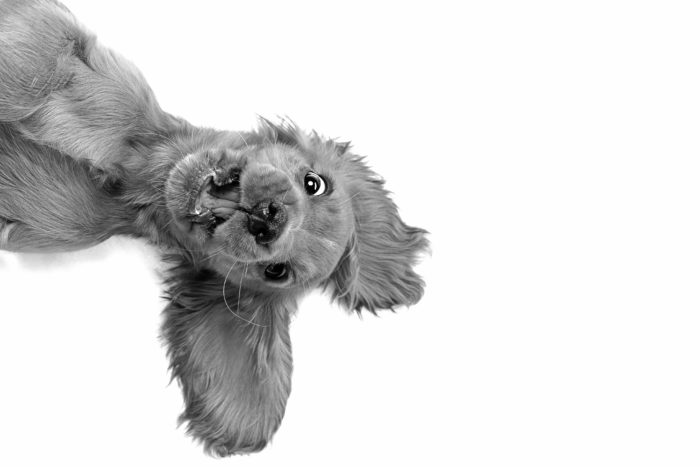
Everyone’s burning question after potty training and puppy biting… how do I get my puppy to walk with me? Let’s reassess goals and focus on a few key foundations. Get comfortable with the steps to a great dog walk. This will kick off many happy walking days ahead.
These are the steps to a great dog walk
- Your mindset and patience.
- Your attention to building comfort with the environment you will be walking in, AKA your socialization game plan.
- Your thoughtful approach to teaching your puppy to disengage from stuff (people, dogs, bikes).
- Your skills with food, the leash, and paying attention to the environment.
Your mindset and patience
Puppies don’t want or need to go on long walks. In her book How To Build A Puppy …into a healthy adult dog, Julia Roberstson provides a framework for exercise based on her world-renowned Galen Myotherapy. In addition to short walks, Julia shares many fun and enriching activities that will help your puppy grow into a physically and emotionally healthy dog. I highly recommend this book.
It can be tough to reimagine our idea of what walking with our dog should look like. But this is often the first step toward an enriching outing for our puppy. Let go of the idea of a 6-foot leash, a sidewalk, and your puppy trotting along in a straight line. And be patient. It takes time to teach leash skills. Stick with me and learn what’s worth focusing on right now.
Comfort in the environment
If you think about it logically, if your puppy is not comfortable in the location you are walking, they can’t learn. A thoughtful socialization game plan will increase your puppy’s comfort, confidence, and their ability to focus on more advanced training when the time is right. Work with a certified coach. Explore the Socialization section on this site. Use the Socialization Checklist not with the goal of checking boxes, but as inspiration. It is not quantity that matters when you teach your puppy about the world. It is the quality of your efforts. Our latest book, Puppy Socialization 2.0, is a comprehensive guide to socialization. A very flexible framework I recommend to my students is to aim for a few novel things in and around the house/neighborhood every day and to get out and about (off the block) at least once a week.

Building a connection
If your puppy is checking in with you as you move along, it’s a good indicator that you’re doing a great job at reinforcing your puppy for looking at you, turning toward you, or coming at you — no recall needed! Teach your puppy that you are fun, interesting, and worth paying attention to. On our YouTube channel, check out Offered Attention, Treat Toss, and Chase Me! Play the follow-me game regularly. These games are fundamental to your walking skills. They are all fun, easy, and puppy-friendly. Play daily. Start at home, then take them on the move.
Another way to strengthen your puppy’s ability to disengage from interesting things in the environment may initially feel counterintuitive. It starts by feeding your puppy while they are looking at something or someone. Leslie McDevitt offers a free webinar with a deep dive into her popular Look At That game. A version of this game should be in everyone’s toolkit.
Your skills
- Be generous when doling out food while interacting with your puppy. Using the right food and enough of it will be game-changing. Aim for at least 8 tiny treats per minute when practicing focused repetitions of something. It is a common rookie mistake to be stingy with blah food; this is not an effective use of food as reinforcement. Get a good treat pouch that also holds your poo bags, and don’t be afraid to get it dirty! (You can wash it regularly with hot, soapy water and let it air dry.) Fill it with high-value food; cooked lean meat is a good bet.
- Watch our long line tutorial and consider investing in a biothane long line. 10 to 15 feet is a good ‘starter’ length. It is essential that your puppy has room to move and is not confined to a short leash and a sidewalk. Short leashes restrict your puppy and set them up to pull. All of this stress can be avoided by practicing with a longer line in a more open space.
- Learn to pay attention to what’s going on around you and how to stay far enough away from things your puppy needs space from. This alone will make a huge difference in how outings go. We are often way too close to other dogs and people. This proximity can cause big feelings. I call it Yay! or Yikes! If your puppy is overwhelmed with big feelings regarding something or someone, this is information for you that you need to move away, create distance. The Skedaddle game is an exit strategy for when you need it! Get a mini training plan for it here.
Slow down… You can’t rush it
Hone your skills! Thoughtful socialization, offered attention games that build connection played inside, offered attention games played outside on a long line, close walking games played in an open space on a long line, close walking games for short periods on the sidewalk. When viewed in this way, the process becomes clear.
Thoughtful attention to these foundations, along with time and maturity, will all merge to produce great walks. Do good work! Enjoy every step along the way.
Check out Puppy Socialization 2.0


